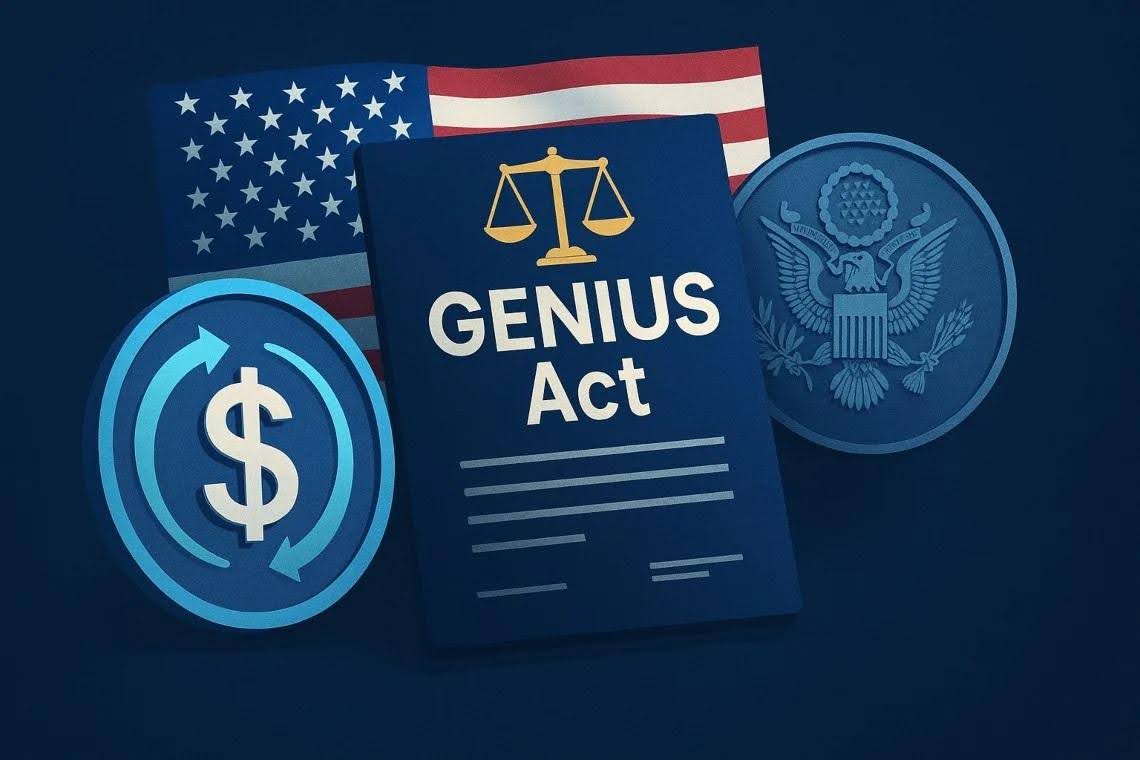Fintech Pulse: The Stablecoin Revolution: How Regulatory Clarity is Reshaping Digital Finance

The financial technology landscape has experienced a seismic shift this week, with regulatory developments, strategic pivots from legacy players, and infrastructure buildouts signaling a fundamental transformation in how digital assets integrate with traditional finance. This comprehensive analysis examines the most significant developments shaping the future of stablecoins, cross-border payments, and the broader fintech ecosystem.
The GENIUS Act: A Regulatory Watershed Moment
The most consequential development in digital finance this week was President Trump's signing of the GENIUS Act into law, establishing the first comprehensive regulatory framework for payment stablecoins in the United States [1]. This landmark legislation represents a fundamental shift in the U.S. government's approach to digital assets, moving from regulatory uncertainty to active embrace of stablecoin technology as a legitimate component of the financial system.
The GENIUS Act creates a dual-track regulatory system that enables both traditional banks and licensed non-bank entities to issue fully reserved, dollar-backed stablecoins under federal and state oversight [1]. The legislation mandates strict reserve requirements, requiring stablecoin issuers to maintain 1:1 backing in cash or U.S. Treasury securities, while explicitly prohibiting interest-bearing stablecoins that could compete with traditional banking products [1]. Perhaps most significantly, the law restricts Big Tech companies from entering the stablecoin issuance market and requires foreign stablecoin providers to register before serving U.S. customers [1].
The strategic implications of this regulatory clarity extend far beyond compliance requirements. As noted in the analysis, "The U.S. just declared stablecoins a legitimate part of its financial system. The strategic shift is already rippling through traditional finance, fintech, and global payments" [1]. This declaration effectively removes the regulatory overhang that has prevented many institutional players from fully embracing stablecoin technology.
The legislation creates several immediate opportunities for financial institutions. Banks can now confidently explore stablecoin custody services, issuance programs, and settlement operations without fear of regulatory backlash [1]. Corporate treasurers gain access to new tools for cross-border payments and cash management, while payment processors can integrate stablecoin rails into their existing infrastructure [1]. The three-year compliance runway provides sufficient time for market participants to adapt their systems and processes to the new regulatory environment [1].
From a macroeconomic perspective, the GENIUS Act reinforces dollar hegemony in the digital age. By requiring stablecoin reserves to be held in U.S. Treasuries, the legislation creates a new source of demand for U.S. government debt while ensuring that the growth of digital dollar usage strengthens rather than undermines the traditional monetary system [1]. This approach addresses longstanding concerns from policymakers about stablecoins potentially destabilizing the financial system or competing with central bank digital currencies.
The competitive landscape for stablecoin issuers will be dramatically reshaped by this new regulatory framework. Compliance-focused issuers who have already invested in regulatory infrastructure and transparency measures are positioned to benefit from the new rules [1]. Conversely, stablecoin providers with more opaque operations, including market leader Tether, face a "comply or exit" scenario for serving U.S. customers [1]. This regulatory arbitrage could accelerate market share shifts toward more transparent and compliant stablecoin offerings.
The infrastructure implications are equally significant. The GENIUS Act is expected to spur massive investment in supporting systems including audit frameworks, know-your-customer (KYC) and identity verification tools, stablecoin application programming interfaces (APIs), and settlement rails that bridge traditional banking and blockchain systems [1]. This infrastructure buildout represents a substantial business opportunity for fintech companies and traditional technology providers alike.
Legacy Players Embrace Digital Transformation: Western Union's Stablecoin Strategy
The regulatory clarity provided by the GENIUS Act has emboldened traditional financial services companies to accelerate their digital asset strategies. Western Union, the global remittance giant, exemplifies this trend with CEO Devin McGranahan's announcement that the company is actively exploring stablecoin use cases across multiple dimensions [1].
Western Union's stablecoin exploration encompasses several strategic initiatives, including the development of global on-ramps and off-ramps for stablecoin conversion, stablecoin-to-fiat exchange services, and integration with digital wallet platforms [1]. The company is already piloting cryptocurrency-related infrastructure in South America and Africa, regions where stablecoins offer particular advantages for cross-border value transfer and local currency volatility hedging [1].
This strategic pivot comes at a critical juncture for Western Union's core business. Despite maintaining its position as the largest consumer money transfer operator globally, generating $4 billion in revenue from approximately $100 billion in transaction volume, the company faces mounting competitive pressure from digital-first challengers [1]. The company's stock has declined 30% over the past year as traditional remittance revenues stagnate, highlighting the urgency of diversification efforts [1].
However, Western Union's exploration of stablecoin integration represents more than defensive positioning. The company's unmatched global distribution network, spanning both retail locations and digital channels, positions it uniquely to serve as a bridge between traditional fiat currencies and emerging stablecoin ecosystems [1]. This infrastructure advantage could prove decisive as stablecoin adoption accelerates in emerging markets where Western Union has historically maintained strong market positions.
The company's digital transformation is already showing promising results in adjacent areas. Payout-to-wallet and payout-to-account services are experiencing growth rates exceeding 30% globally, demonstrating consumer appetite for hybrid digital payment solutions [1]. This trend reinforces Western Union's strategic shift from pure cash-based transactions to integrated digital payment rails that can accommodate both traditional and blockchain-based settlement mechanisms.
Western Union's stablecoin strategy reflects broader industry recognition that digital asset adoption is increasingly driven by institutional mandates rather than grassroots user demand [1]. As regulatory frameworks like the GENIUS Act provide clarity and legitimacy to stablecoin operations, board-level directives are pushing traditional financial institutions to develop comprehensive digital asset strategies or risk competitive displacement.
The potential for Western Union to serve as a global stablecoin on-ramp and off-ramp infrastructure provider represents a significant business opportunity. The company's existing compliance frameworks, regulatory relationships, and operational presence in over 200 countries and territories provide a foundation for stablecoin integration that would be difficult and expensive for newer entrants to replicate [1]. Success in this transformation could position Western Union as an essential infrastructure provider in the emerging stablecoin economy, potentially revitalizing growth prospects and stock performance.
PayPal World: Distribution-First Strategy in Cross-Border Payments
While regulatory developments and stablecoin adoption dominate fintech headlines, PayPal's announcement of PayPal World demonstrates an alternative strategic approach to solving cross-border payment challenges. The new platform, launching this fall, represents a distribution-first methodology that prioritizes network effects and user experience over open protocol adoption [1].
PayPal World creates an interconnected ecosystem linking major domestic payment platforms including India's Unified Payments Interface (UPI), China's Tenpay, and Latin America's Mercado Pago with PayPal and Venmo's global merchant network [1]. This integration enables consumers to pay international merchants using their preferred local payment methods and currencies, while businesses gain access to nearly 2 billion users without requiring additional technical integration [1].
The platform's architecture reflects PayPal's strategic philosophy of controlled interoperability. Built on open commerce APIs and described as technology-agnostic, PayPal World maintains a proprietary network structure where external wallets "connect" rather than participate permissionlessly [1]. This approach contrasts sharply with blockchain-native solutions that prioritize open protocols and decentralized access.
PayPal's decision to defer stablecoin integration while focusing on traditional payment rail connectivity reveals important strategic insights about the current state of cross-border payments [1]. Rather than immediately embracing blockchain-based settlement, PayPal is betting that distribution advantages and user experience optimization will prove more valuable than protocol-level innovation in the near term.
This distribution-first approach addresses several practical challenges that pure stablecoin solutions have yet to fully resolve. Consumer familiarity with existing payment methods, regulatory compliance across multiple jurisdictions, and merchant acceptance networks all favor integrated traditional payment systems over newer blockchain-based alternatives [1]. PayPal World leverages these existing advantages while creating infrastructure that can eventually accommodate stablecoin integration as market conditions evolve.
The strategic implications extend beyond immediate competitive positioning. PayPal's approach suggests that successful cross-border payment solutions may require hybrid architectures that combine traditional payment rails with emerging blockchain technologies [1]. By establishing control over distribution endpoints and user relationships, PayPal positions itself to influence how stablecoins and other digital assets integrate with consumer payment experiences.
The platform also creates significant opportunities for developers and third-party service providers. PayPal World's API-first architecture enables the development of payments-enabled applications, artificial intelligence agents, and commerce tools that can leverage the platform's two-sided network effects [1]. This developer ecosystem approach mirrors successful platform strategies in other technology sectors and could accelerate innovation in cross-border commerce applications.
However, PayPal's controlled network approach faces inherent limitations compared to open protocol alternatives. While the company can optimize user experience and ensure compliance within its ecosystem, the platform's growth potential is ultimately constrained by PayPal's ability to negotiate partnerships and maintain relationships with domestic payment providers [1]. Open stablecoin protocols, by contrast, can achieve global interoperability without requiring bilateral agreements or centralized coordination.
The timing of PayPal World's launch, coinciding with increased regulatory clarity for stablecoins, suggests that the company views distribution control as a prerequisite for eventual blockchain integration rather than an alternative to it [1]. This sequenced approach—establishing network effects first, then adding blockchain settlement capabilities—may prove more sustainable than attempting to build both simultaneously.
Ecosystem Acceleration: Product Launches and Strategic Partnerships
The regulatory clarity provided by the GENIUS Act has catalyzed a wave of product launches, strategic partnerships, and adoption announcements across the broader fintech ecosystem. These developments collectively demonstrate how regulatory certainty enables accelerated innovation and market entry across multiple segments of the digital finance value chain.
Institutional Infrastructure Development
Several major developments highlight the rapid buildout of institutional-grade stablecoin infrastructure. Perena's announcement of USD', a new stablecoin backed by Franklin Templeton's BENJI and Superstate's USTB tokens on the Solana blockchain, exemplifies the trend toward yield-bearing stablecoin alternatives that comply with regulatory frameworks while providing institutional-grade backing [1]. This approach addresses the GENIUS Act's prohibition on interest-bearing stablecoins by utilizing tokenized Treasury products as reserve assets.
Ondo Finance's launch of the first tokenized Treasury fund on the Sei blockchain, backed by World Liberty Financial, demonstrates growing institutional appetite for blockchain-native Treasury products [1]. These tokenized Treasury offerings serve dual purposes: providing compliant reserve assets for stablecoin issuers while creating new distribution channels for traditional fixed-income products.
The international response to U.S. regulatory developments is equally significant. ChinaAMC's launch of the first tokenized renminbi money market fund in Hong Kong represents a strategic response to U.S. stablecoin leadership, potentially creating infrastructure for yuan-denominated stablecoins that could compete with dollar-based alternatives [1]. This development highlights how regulatory clarity in one jurisdiction can accelerate competitive responses globally.
Traditional Finance Integration
The integration of stablecoin capabilities into traditional financial services is accelerating rapidly. Charles Schwab's increased focus on cryptocurrency and stablecoin services demonstrates how established brokerages are responding to client demand for digital asset exposure [1]. The company's strategic emphasis on stablecoins over broader tokenization initiatives suggests recognition that payment-focused digital assets offer more immediate practical value than speculative tokenization projects.
American Express CEO's characterization of stablecoins as an "alternative" payment method signals growing acceptance among traditional payment processors [1]. This acknowledgment from a major card network indicates that stablecoins are transitioning from competitive threats to complementary payment options that can enhance rather than replace existing infrastructure.
The expansion of existing stablecoin offerings also demonstrates market maturation. PayPal USD's expansion to the Arbitrum blockchain reflects the multi-chain strategy that many stablecoin issuers are adopting to maximize utility and adoption [1]. This approach acknowledges that blockchain interoperability remains essential for stablecoin success, even as regulatory frameworks provide clarity for individual implementations.
Emerging Use Cases and Applications
Several developments highlight expanding use cases for stablecoin technology beyond basic payments. Polymarket's consideration of launching its own stablecoin demonstrates how prediction markets and other decentralized applications are exploring vertical integration to reduce dependency on external stablecoin providers [1]. This trend toward application-specific stablecoins could create new competitive dynamics in the broader stablecoin ecosystem.
The growth of USDC on Hyperliquid to $4.9 billion illustrates how decentralized exchange derivatives trading is driving stablecoin adoption in sophisticated trading applications [1]. This institutional trading use case represents a significant growth vector for stablecoin adoption that extends well beyond retail payments or remittances.
Telegram's TON Wallet launch in the United States, bringing cryptocurrency integration to millions of users, demonstrates how messaging platforms are becoming distribution channels for digital asset adoption [1]. The integration of stablecoin functionality into communication platforms could accelerate mainstream adoption by reducing friction for peer-to-peer transfers and micropayments.
Capital Market Developments
The capital markets response to stablecoin regulatory clarity is equally significant. BitGo's filing to go public as the cryptocurrency market surges past $4 trillion in total value demonstrates growing investor confidence in digital asset infrastructure companies [1]. The timing of this public offering coincides with regulatory clarity that reduces business model uncertainty for cryptocurrency service providers.
Ethena Foundation's plan to establish StablecoinX, a special purpose acquisition company (SPAC) dedicated to purchasing millions of dollars worth of ENA tokens, represents a novel approach to stablecoin ecosystem investment [1]. This structure could provide a template for other stablecoin projects seeking to attract institutional capital while maintaining decentralized governance structures.
Global Regulatory Response and Competitive Dynamics
The passage of the GENIUS Act has triggered a complex web of international regulatory responses and competitive positioning as governments worldwide grapple with the implications of U.S. stablecoin leadership. These developments reveal both the global influence of U.S. financial regulation and the emerging competition for digital asset regulatory supremacy.
International Regulatory Divergence
JPMorgan's observation that regulators outside the United States appear to prefer tokenized bank deposits over traditional stablecoins highlights a fundamental philosophical divide in digital asset regulation [1]. This preference reflects concerns about monetary sovereignty and financial stability that differ significantly from the U.S. approach of embracing private stablecoin issuance under regulatory oversight.
The European Central Bank's continued work on digital euro development represents a central bank digital currency (CBDC) approach that competes directly with private stablecoin initiatives [1]. The ECB's strategy prioritizes government control over monetary policy and payment systems, contrasting sharply with the U.S. model of regulated private issuance. This divergence could create significant interoperability challenges as different regions pursue incompatible digital currency architectures.
Russia's announcement of a 2026 launch date for its digital ruble, despite public wariness, demonstrates how geopolitical considerations are driving CBDC development timelines [1]. The Russian approach appears motivated by desires to reduce dependence on dollar-denominated payment systems, highlighting how digital currency development is becoming intertwined with broader geopolitical competition.
Regional Innovation and Competition
The United Kingdom's announcement of plans for DIGIT, a digital bond initiative that expresses willingness to decentralize market infrastructure, represents a middle path between centralized CBDC approaches and fully private stablecoin systems [1]. This hybrid approach could provide a template for other jurisdictions seeking to balance innovation with regulatory control.
Hong Kong's financial regulator's warning that markets have become "overly excited" about stablecoins reflects the challenges facing international financial centers as they attempt to balance innovation with financial stability [1]. The regulator's cautious stance contrasts with Hong Kong's historical role as a financial innovation hub and may reflect broader Chinese government concerns about private digital currency adoption.
The Swiss National Bank's expansion of wholesale CBDC trials demonstrates how smaller, innovation-focused jurisdictions are using digital currency development to maintain competitive advantages in global finance [1]. Switzerland's approach focuses on wholesale applications that could enhance the country's role in international banking and trade finance.
Central Bank Dilemmas
The rise of dollar-backed stablecoins creates significant dilemmas for central banks worldwide, as noted in recent analysis [1]. These digital dollars extend U.S. monetary influence globally while potentially undermining local currency usage and monetary policy effectiveness. Central banks must balance the efficiency benefits of stablecoin adoption against the risks of reduced monetary sovereignty.
This dynamic is particularly acute in emerging markets where dollar-backed stablecoins offer attractive alternatives to volatile local currencies. The widespread adoption of stablecoins in these markets could accelerate dollarization trends while reducing central banks' ability to implement effective monetary policy. The GENIUS Act's requirement for Treasury backing of stablecoins amplifies these effects by creating additional demand for U.S. government debt.
Regulatory Arbitrage and Compliance Challenges
The U.S. banking associations' objections to trust bank charters for major stablecoin issuers including Circle, Fidelity, and Ripple highlight ongoing tensions within the traditional banking sector [1]. These objections reflect concerns about competitive advantages that specialized digital asset firms might gain through regulatory arbitrage, as well as broader questions about the appropriate regulatory treatment of stablecoin issuers.
The requirement for foreign stablecoin providers to register before serving U.S. customers creates significant compliance challenges for international issuers [1]. This extraterritorial reach of U.S. regulation could force global stablecoin providers to choose between compliance with U.S. requirements and serving other markets with conflicting regulatory frameworks.
Legislative Developments and Policy Evolution
The Senate's cryptocurrency bill, which takes a different approach from the previously proposed CLARITY Act, demonstrates the evolving nature of U.S. digital asset regulation beyond stablecoins [1]. These parallel legislative efforts suggest that stablecoin regulation, while significant, represents only one component of a broader regulatory transformation affecting the entire digital asset ecosystem.
The Anti-CBDC Surveillance Act's provision that it should not prevent wholesale CBDC development or tokenized reserves indicates the complex balance policymakers are attempting to strike between privacy concerns and financial innovation [1]. This nuanced approach suggests that regulatory frameworks will continue evolving as practical experience with digital asset implementation grows.
The global regulatory response to the GENIUS Act reveals both the influence of U.S. financial regulation and the limits of that influence in an increasingly multipolar world. While the U.S. approach may become a template for other jurisdictions, significant variations in implementation seem likely as different countries balance innovation, sovereignty, and stability concerns according to their specific economic and political contexts.
Strategic Implications and Future Outlook
The convergence of regulatory clarity, institutional adoption, and infrastructure development creates unprecedented opportunities and challenges for stakeholders across the financial services ecosystem. Understanding these strategic implications is essential for positioning in the rapidly evolving digital finance landscape.
Competitive Repositioning in Financial Services
The GENIUS Act fundamentally alters competitive dynamics within financial services by legitimizing stablecoin technology while creating new regulatory moats. Traditional banks that successfully integrate stablecoin capabilities into their service offerings gain access to new revenue streams including custody fees, issuance services, and blockchain-based settlement operations [1]. However, banks that fail to adapt risk losing market share to more agile fintech competitors and specialized digital asset service providers.
The three-year compliance runway provides a critical window for strategic positioning, but this timeline also creates urgency for institutions that have not yet developed digital asset capabilities [1]. Early movers in stablecoin integration are likely to capture disproportionate market share as regulatory clarity removes adoption barriers and institutional demand accelerates.
Payment processors face particularly complex strategic decisions as stablecoins offer both opportunities for enhanced services and threats to existing revenue models. Companies like Western Union that embrace stablecoin integration as a core strategic initiative may successfully transition from legacy remittance providers to essential infrastructure for the digital economy [1]. Conversely, payment companies that view stablecoins as peripheral to their core business risk displacement by more digitally native competitors.
Infrastructure Investment and Market Development
The regulatory framework established by the GENIUS Act is expected to catalyze massive infrastructure investment across multiple sectors. Audit and compliance systems specifically designed for stablecoin operations represent immediate business opportunities for professional services firms and technology providers [1]. The requirement for transparent reserve management and regular attestations creates sustained demand for specialized audit capabilities that traditional accounting firms are well-positioned to provide.
Know-your-customer (KYC) and identity verification systems tailored for stablecoin transactions represent another significant growth area. The integration of blockchain-based payments with traditional compliance frameworks requires sophisticated technology solutions that can bridge these different operational paradigms [1]. Companies that successfully develop these bridging technologies may capture substantial market share as stablecoin adoption accelerates.
Application programming interface (API) development for stablecoin integration presents opportunities for both established financial technology companies and emerging startups. The need for seamless integration between traditional banking systems and blockchain-based stablecoin infrastructure creates demand for middleware solutions that can abstract technical complexity while ensuring regulatory compliance [1].
Global Competitive Dynamics
The U.S. regulatory approach to stablecoins creates significant first-mover advantages for American financial institutions and technology companies. The requirement for Treasury backing of stablecoins reinforces dollar dominance in digital payments while creating sustained demand for U.S. government debt [1]. This structural advantage may prove difficult for other jurisdictions to overcome, even with alternative regulatory approaches.
However, the international response to U.S. stablecoin regulation suggests that competitive alternatives will emerge. The development of yuan-denominated stablecoins, euro-based digital currencies, and other regional alternatives could fragment the global stablecoin market along geopolitical lines [1]. Financial institutions with global operations must prepare for a multipolar digital currency environment that requires sophisticated treasury management and compliance capabilities.
The tension between open protocol development and controlled platform strategies, exemplified by the contrast between stablecoin approaches and PayPal World's distribution-first methodology, will likely define competitive dynamics in cross-border payments [1]. Success may require hybrid approaches that combine the efficiency of open protocols with the user experience and compliance advantages of controlled platforms.
Technology Evolution and Integration Challenges
The integration of stablecoin capabilities with existing financial infrastructure presents significant technical challenges that will influence competitive outcomes. Legacy banking systems were not designed for blockchain-based settlement, requiring substantial technology investments and operational changes [1]. Institutions that successfully navigate these integration challenges will gain sustainable competitive advantages, while those that struggle with technical implementation may find themselves at permanent disadvantages.
The multi-chain nature of stablecoin deployment creates additional complexity for financial institutions seeking to offer comprehensive digital asset services. Supporting multiple blockchain networks requires sophisticated technical infrastructure and operational expertise that may favor specialized technology providers over traditional financial institutions [1]. Strategic partnerships between banks and blockchain technology companies may prove essential for successful stablecoin integration.
Interoperability between different stablecoin implementations and blockchain networks remains a critical challenge that could influence market structure. Solutions that enable seamless value transfer between different stablecoin systems may capture significant market share by reducing friction for users and businesses operating across multiple platforms [1].
Risk Management and Operational Considerations
The regulatory framework established by the GENIUS Act addresses many systemic risks associated with stablecoin adoption, but operational risks remain significant for individual institutions. Reserve management requirements create new operational complexities for stablecoin issuers, particularly regarding the segregation of customer funds and the management of Treasury securities [1]. Institutions must develop sophisticated risk management frameworks that address both traditional financial risks and novel operational challenges specific to blockchain-based systems.
Cybersecurity risks associated with stablecoin operations require specialized expertise and infrastructure investments. The irreversible nature of blockchain transactions amplifies the consequences of security breaches, making robust cybersecurity frameworks essential for successful stablecoin operations [1]. Institutions that underinvest in cybersecurity capabilities may face catastrophic losses that could eliminate competitive advantages gained through early stablecoin adoption.
Regulatory compliance across multiple jurisdictions presents ongoing challenges for institutions with international operations. The extraterritorial reach of U.S. stablecoin regulation may conflict with local regulatory requirements in other markets, requiring sophisticated legal and compliance frameworks [1]. Institutions must develop capabilities to navigate these complex regulatory environments while maintaining operational efficiency.
Conclusion: Navigating the New Digital Finance Paradigm
The developments analyzed in this newsletter represent more than incremental progress in financial technology—they signal a fundamental transformation in how money moves, how payments are processed, and how financial institutions compete in the global economy. The GENIUS Act's establishment of comprehensive stablecoin regulation removes the primary barrier to institutional adoption while creating new competitive dynamics that will reshape the financial services landscape.
The strategic responses from legacy players like Western Union and PayPal demonstrate that digital asset integration is no longer optional for major financial institutions. The choice is not whether to embrace stablecoin technology, but how quickly and effectively to implement integration strategies that capture new opportunities while managing associated risks. Institutions that successfully navigate this transition will gain sustainable competitive advantages, while those that delay or mismanage digital asset adoption risk obsolescence.
The global regulatory response to U.S. stablecoin leadership reveals both the influence of American financial regulation and the emergence of alternative approaches that could fragment the digital currency landscape. Financial institutions with international operations must prepare for a complex regulatory environment that requires sophisticated compliance capabilities and strategic flexibility.
The infrastructure buildout catalyzed by regulatory clarity creates substantial business opportunities across multiple sectors, from professional services to technology development. Companies that successfully develop solutions for the emerging stablecoin economy may capture significant market share as adoption accelerates and institutional demand grows.
Perhaps most importantly, the developments covered in this analysis demonstrate that the integration of traditional finance and blockchain technology is no longer a future possibility—it is a present reality that requires immediate strategic attention. The institutions and individuals who recognize this transformation and act decisively will be best positioned to thrive in the new digital finance paradigm.
As we move forward, the key success factors will include regulatory compliance, technical integration capabilities, risk management expertise, and strategic partnerships that bridge traditional and digital finance ecosystems. The window for strategic positioning is open, but it will not remain so indefinitely. The time for action is now.
References
[1] Okpalugo, C. (2025, July 24). GENIUS Act signed into law (TWS 7/24). The Weekly Stable - This Week in Fintech. Retrieved from newsletter content provided.
This analysis is based on information from The Weekly Stable newsletter published by This Week in Fintech on July 24, 2025.
Written by Bogdan Cristei and Manus AI



